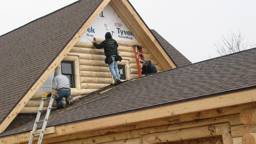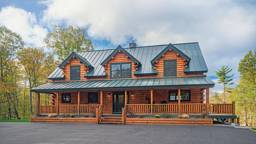 You’ve been bitten by the bug. It’s the top of the first inning. Your dining room table is spread with log-home sales literature, and everywhere are stacks of log-home magazines. Now the name of the game is turning your dream into a reality. But whom should you be talking to and when? Think of it as the great game of building a log home. But before you begin, it’s a good idea to understand the players and their positions. Here is the roster for your log-home dream team in the order you are likely to encounter them. (Not all will be on the field at the same time and not all used in every match.)
You’ve been bitten by the bug. It’s the top of the first inning. Your dining room table is spread with log-home sales literature, and everywhere are stacks of log-home magazines. Now the name of the game is turning your dream into a reality. But whom should you be talking to and when? Think of it as the great game of building a log home. But before you begin, it’s a good idea to understand the players and their positions. Here is the roster for your log-home dream team in the order you are likely to encounter them. (Not all will be on the field at the same time and not all used in every match.) 1. Log-Home Company Representative. Most people’s first contact with a log-home manufacturer is through a company representative. This may be a salesperson working through a company office or an independent representative or “dealer.” Dealers that offer construction services are “builder-dealers.”
2. Handcrafter. Unlike a log-home manufacturer, a handcrafter is an independent business person who provides log “shells” for homeowners or general contractors to use in building log homes. Most handcrafters are small businesses without separate sales or design staffs.
3. Log-Company Designer. Many log-home manufacturers have design departments. These are usually staffed by people experienced in log-home design although rarely are they trained, licensed architects. Designers are very familiar with the company’s products and at producing plans with their specifications.
4. Architect. Architects are professionally trained in all aspects of designing buildings. In addition to preparing conceptual designs, architects prepare construction documents for all aspects of construction. Many architects also offer construction management or consulting to see their designs carried through to completion. If the homeowner is working with a log-home company, the company may insist on redrawing the architect’s plans with its specific construction details. Be sure you understand the requirements of a log company before involving an architect in your project.
5. Engineer. Like architects, engineers are licensed by the state. However, engineers concern themselves only with the structural integrity of your home. If your plans have been prepared by someone who does not hold an architect’s license (usually the case when dealing with log-home companies), the building-code authority may require that the plans be reviewed and sealed by a licensed professional engineer.
6. Loan Officer. Loan officers handle loan applications for lenders.
7. General contractor. The general contractor, or GC, is like the conductor of an orchestra. His job is to take the plans you’ve had committed to paper by your architect or log-company designer and see that they become reality. Some GCs have crews who perform some or all of the labor required to build your home, while others subcontract with independent subcontractors. When you sign a contract with a GC, he becomes responsible for all aspects of your project.
8. Project Manager. When homeowners want to act as their own GC but have limited time or experience, they may call upon the services of a project manager. This person or company acts as the owner’s representative, advising owners and handling relationships with subcontractors and suppliers.
9. Architectural Review Committee. Today, many log homes are built in subdivisions or tract developments. These often have restrictive covenants to control the appearance, style and quality of the development. Many developments have an architectural review committee, consisting of homeowners within the development, that must approve any new construction.
10. Fire marshal. Many log homes are built in rural areas, far from community fire protection. Some building-code authorities will require that you have your site plan and blueprints reviewed and approved by the local fire marshal.
11. Plan Reviewer. When you apply for a building permit in most jurisdictions, your plans are first turned over to the plan reviewer, who will examine them to be sure they meet applicable building codes.
12. Subcontractors. When construction begins, your project will see a parade of subcontractors, or subs, performing various activities to complete your home. If you are working with a GC, the subs will work through and answer to the GC, who, in turn, answers to you. Usually subs work with one or more assistants, so your project may see from 50 to 100 workers before completion.
13. Builder. Some people confuse builders and GCs. It’s an easy mistake to make because in some instances the builder actually acts as GC. Builders, however, have their own construction crew and contribute physical labor to the construction process. Sometimes a homeowner hires a builder who also arranges subcontracts with the foundation and mechanical subcontractors. In such cases, the builder is acting either as a GC or project manager for the homeowner.
14. Construction Manager. Sometimes people use the term construction manager interchangeably with project manager. Actually, the construction manager’s responsibilities are usually confined to actual construction, supervising jobsite activities, communicating with subs and suppliers to keep on schedule, monitoring progress and making sure the home is built according to the construction documents.
15. Material Suppliers. Your project will require a lot of materials not associated with your log package. If you are working with a GC, he will handle arrangements with material suppliers. If you are working on your own, you will be responsible for determining what materials are needed, their quantities and when they should be on the job.
16. Title Company Representative. In some cases, where homeowners are using outside financing, the lender may require use of a title company. This company assumes responsibility for managing the financing of the project, including disbursement of funds.
17. Building Inspector. Building inspectors are responsible for enforcing the prevailing building codes. The role of building inspector varies widely with the jurisdiction—city, county or township. In a typical situation, after the building permit is issued, building inspectors visit your site at specific stages of construction and must approve the work before the project can continue.
18. Bank Inspector. If the project requires financing, the lender (or title company) usually requires that one of its representatives visits the site to ensure that the work for which payment is requested has actually been accomplished.
Jim Cooper, a log-home consultant and project manager, is the author of Log Homes Made Easy and the Log Home Project Planner.
This story ran longer, with more detail and advice, in the 2008 Log Homes Illustrated Annual Buyer's Directory.











